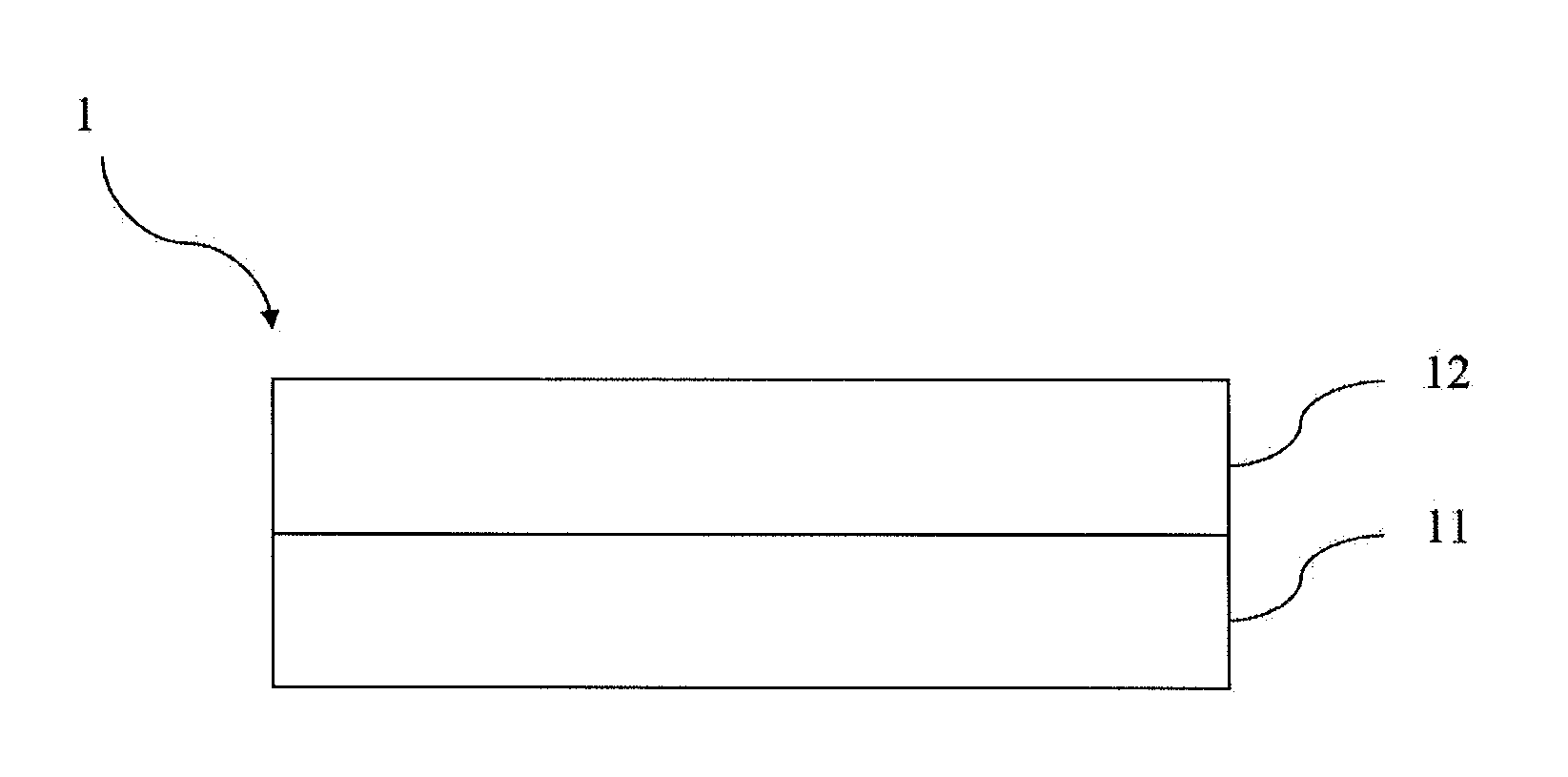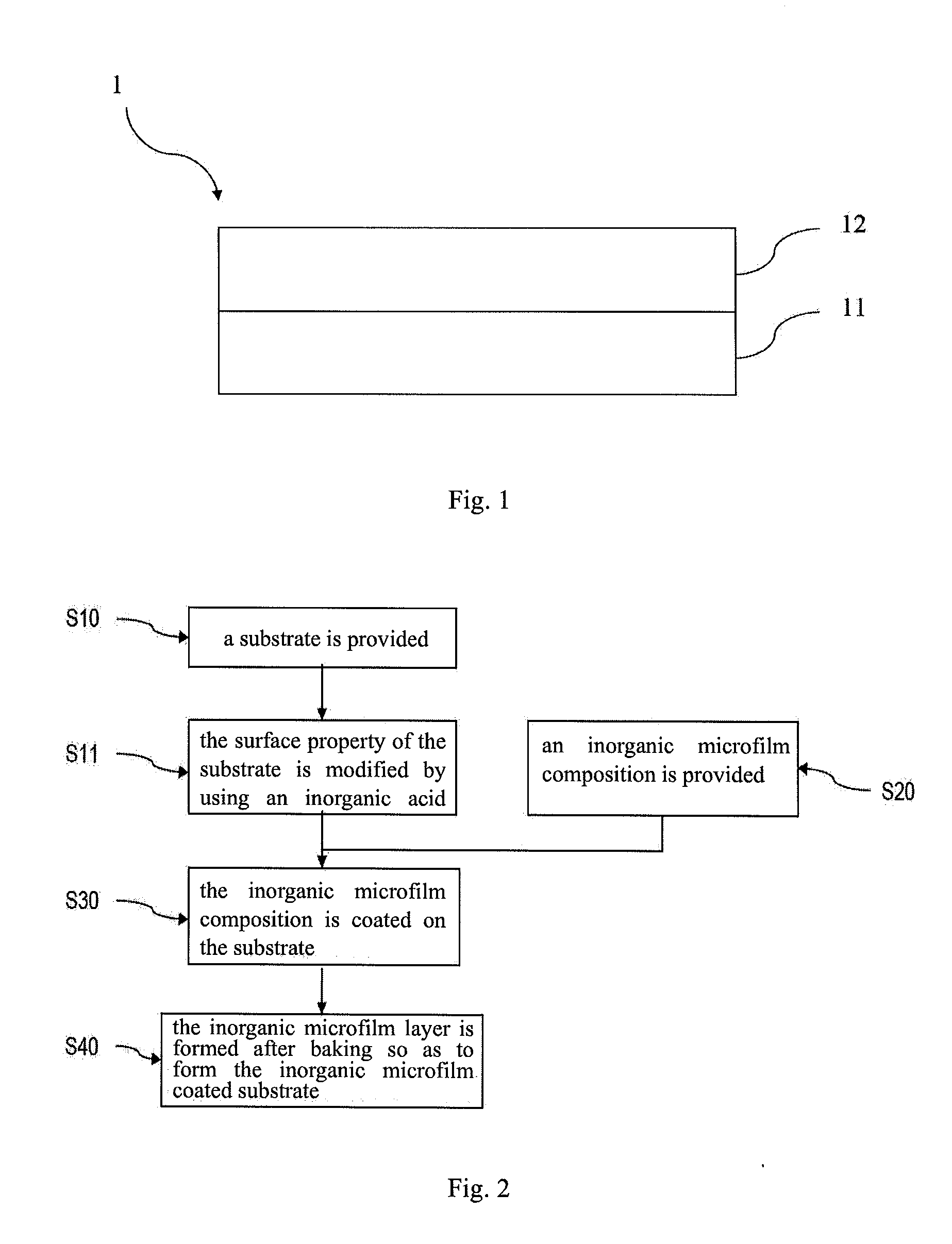Inorganic microfilm coated substrate and method thereof
a technology of inorganic microfilm and substrate, applied in the direction of coatings, glass/slag layered products, chemistry apparatus and processes, etc., can solve the problems of oxide layer peeling, inability to endure collision, gradual loss of protection function,
- Summary
- Abstract
- Description
- Claims
- Application Information
AI Technical Summary
Benefits of technology
Problems solved by technology
Method used
Image
Examples
embodiment 1
[0023]Pure water 1000 g (that is, 1000 ml) and Li2O 20 g are poured into a first stirred tank, and then they are mixed by high speed stirring under room-temperature so as to form a Li2O solution.
[0024]A SiO2 solution 300 g is poured into a second stirred tank, and the second stirred tank is placed in a water tank with the temperature of 40-80° C., and the temperature of SiO2 solution in the second stirred tank is heated to 30-70° C. by a hydrothermal synthesis such that SiO2 solution changes into a form of sol.
[0025]The Li2O solution in the first stirred tank is slowly poured into the second stirred tank with keeping continuously high speed stirring and also maintaining the temperature of the second stirred tank within 30-70° C. so as to form a Li2SiO3 solution.
[0026]A K2SiO3 solution 500 g with Young's modulus between 2 and 6 of SiO2 and K2O is poured into a third stirred tank, and the K2SiO3 solution is heated to a temperature of 30-70° C.
[0027]A Li2SiO3 solution in the second sti...
embodiment 2
[0029]A K2SiO3 solution 500 g with Young's modulus between 2 and 6 of SiO2 and K2O is poured into a first stirred tank, and the K2SiO3 solution is heated to a temperature of 30-70° C.
[0030]Pure water 1000 g and Li2O 20 g are poured into a second stirred tank, and then they are mixed by high speed stirring under room-temperature to form a Li2O solution.
[0031]A SiO2 solution 300 g is poured into a third stirred tank, and the third stirred tank is placed in a water tank with the temperature of 40-80° C., and the temperature of SiO2 solution in the third stirred tank is heated to 30-70° C. by a hydrothermal synthesis such that SiO2 solution changes into a form of sol.
[0032]The K2SiO3 solution in the first stirred tank and the Li2O solution in the second stirred tank are slowly pour into a third stirred tank in sequence, and then they are mixed by continuously high speed stirring and also maintaining the temperature of the third stirred tank at about 60° C. until the solution in the thir...
embodiment 3
[0034]A SiO2 solution 300 g is poured into a first stirred tank, and the first stirred tank is placed in a water tank with the temperature of 40-80° C., and the temperature of SiO2 solution in the first stirred tank is heated to 30-70° C. by a hydrothermal synthesis such that SiO2 solution changes into a form of sol.
[0035]A K2SiO3 solution 500 g with Young's modulus between 2 and 6 of SiO2 and K2O is poured into a second stirred tank, and the K2SiO3 solution is heated to a temperature of 30-70° C.
[0036]Pure water 1000 ml and Li2O 20 g are poured into a third stirred tank, and then they are mixed by high speed stirring under room-temperature so as to form a Li2O solution.
[0037]The SiO2 solution in the first stirred tank and the K2SiO3 solution in the second stirred tank are slowly pour into a third stirred tank in sequence, and then they are mixed by continuously high speed stirring and also maintaining the temperature of the third stirred tank at about 60° C. until the solution in t...
PUM
| Property | Measurement | Unit |
|---|---|---|
| temperature | aaaaa | aaaaa |
| temperature | aaaaa | aaaaa |
| temperature | aaaaa | aaaaa |
Abstract
Description
Claims
Application Information
 Login to View More
Login to View More - R&D
- Intellectual Property
- Life Sciences
- Materials
- Tech Scout
- Unparalleled Data Quality
- Higher Quality Content
- 60% Fewer Hallucinations
Browse by: Latest US Patents, China's latest patents, Technical Efficacy Thesaurus, Application Domain, Technology Topic, Popular Technical Reports.
© 2025 PatSnap. All rights reserved.Legal|Privacy policy|Modern Slavery Act Transparency Statement|Sitemap|About US| Contact US: help@patsnap.com


